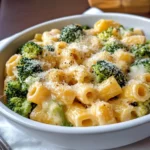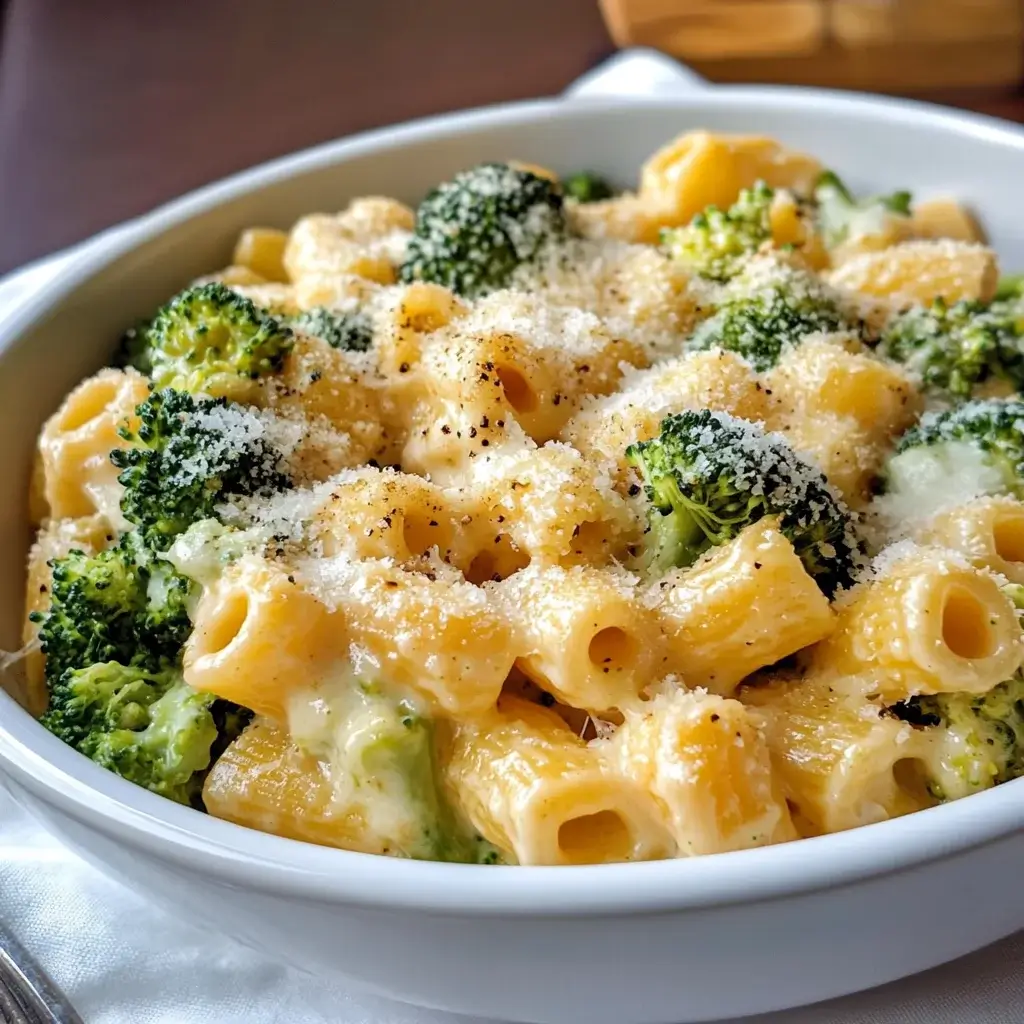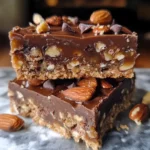It was one of those Tuesday evenings – the kind where energy levels are dipping, deadlines are looming, and the thought of cooking an elaborate meal feels akin to climbing a mountain. My family, particularly my usually picky youngest, was already starting the “what’s for dinner?” chorus. I needed something quick, comforting, and preferably, something that wouldn’t result in a battle of wills over uneaten vegetables. That’s when I remembered a scribbled note for a Creamy Vegetarian Broccoli Cheddar Pasta. I’d been meaning to try it, drawn by the promise of a one-pan wonder (or close to it) that combined the holy trinity of comfort: pasta, cheese, and a creamy sauce. Skeptical but hopeful, I gathered the ingredients. To say this dish was a revelation would be an understatement. The aroma alone, a rich blend of melting cheddar, savory garlic, and fresh broccoli, had everyone migrating to the kitchen. The first bite was pure bliss – tender pasta enveloped in a velvety, cheesy sauce, punctuated by perfectly cooked broccoli florets that still had a hint of bite. My son, who usually inspects broccoli like it’s an alien specimen, devoured his entire bowl and, to my utter astonishment, asked for seconds! Since that fateful Tuesday, this Creamy Vegetarian Broccoli Cheddar Pasta has become a beloved staple in our home. It’s our go-to for busy weeknights, a comforting hug on a chilly day, and even a dish I’m proud to serve when friends come over. It’s wonderfully adaptable, surprisingly easy to whip up, and consistently delivers on flavor and satisfaction. This isn’t just a recipe; it’s a peacekeeper, a crowd-pleaser, and a testament to the fact that simple ingredients can create something truly magical. If you’re searching for a vegetarian pasta dish that’s both incredibly delicious and wonderfully straightforward, look no further. Prepare to fall in love with this cheesy, creamy, broccoli-packed delight!
Ingredients
Here’s what you’ll need to create this luscious Creamy Vegetarian Broccoli Cheddar Pasta, a dish that’s sure to become a family favorite. Each ingredient plays a crucial role in building layers of flavor and texture, resulting in a truly satisfying meal.
- 1 pound (450g) Pasta of your choice: We recommend medium shells, rotini, cavatappi, or penne. These shapes are fantastic for capturing the creamy cheddar sauce. Choose a good quality dried pasta for the best texture. Whole wheat pasta can also be used for an added nutritional boost, though cooking times may vary slightly.
- 1 large head of Broccoli (about 1.5 lbs or 680g), cut into small florets: Fresh, vibrant green broccoli florets provide a wonderful color, a pleasant, slightly earthy flavor, and a delightful textural contrast to the creamy pasta. Ensure the florets are cut into bite-sized pieces for even cooking.
- 2 tablespoons Unsalted Butter: This forms the base of our roux, contributing to the richness and smoothness of the cheese sauce. Using unsalted butter allows you to control the overall sodium content of the dish.
- 1 medium Yellow Onion, finely chopped (about 1 cup): The subtle sweetness of sautéed yellow onion builds a foundational aromatic layer for the sauce. Finely chopping ensures it melts into the sauce beautifully.
- 3 cloves Garlic, minced: Freshly minced garlic adds a pungent, savory depth that complements the cheese and broccoli perfectly. Avoid garlic powder for the best, most authentic flavor.
- 1/4 cup All-Purpose Flour: This is the thickening agent for our creamy sauce. When cooked with the butter, it creates a roux that prevents the sauce from being too thin or watery.
- 2 cups Vegetable Broth: A good quality vegetable broth adds a savory umami element and liquid base to the sauce. Choose a low-sodium option if you’re monitoring salt intake.
- 1.5 cups Milk (whole milk or 2% recommended): Milk contributes to the creaminess and richness of the sauce. Whole milk will yield the creamiest result, but 2% milk also works well. For a richer sauce, you could even use half-and-half or light cream for part of the milk.
- 1 teaspoon Dijon Mustard: This is a secret weapon! Dijon mustard adds a subtle tang and depth of flavor that enhances the cheesiness without tasting overtly of mustard. It helps to balance the richness of the sauce.
- 1/2 teaspoon Smoked Paprika (optional, but recommended): Smoked paprika lends a gentle, smoky warmth that beautifully complements the cheddar cheese. Sweet paprika can be used as an alternative if you prefer.
- Salt and freshly ground Black Pepper to taste: Essential for seasoning every layer of the dish. Be sure to taste and adjust seasoning at various stages, especially before serving.
- 8 ounces (225g) Sharp Cheddar Cheese, freshly grated: The star of the show! Freshly grating your cheese from a block is highly recommended. Pre-shredded cheeses often contain anti-caking agents that can prevent them from melting smoothly, resulting in a grainy sauce. A good quality sharp cheddar will provide the best flavor.
- 4 ounces (113g) Cream Cheese, cut into cubes (optional, for extra creaminess): While optional, adding cream cheese takes the sauce to another level of velvety smoothness and adds a subtle tangy richness. Ensure it’s at room temperature for easier melting.
- Fresh Parsley, chopped (for garnish, optional): A sprinkle of fresh parsley adds a touch of color and freshness to the finished dish.
Instructions
Follow these simple steps to create your delicious Creamy Vegetarian Broccoli Cheddar Pasta. Take your time with each step, especially when making the sauce, to ensure a perfectly smooth and flavorful result.
- Cook the Pasta: Bring a large pot of salted water to a rolling boil. Add your chosen pasta and cook according to package directions until al dente – tender but still with a slight bite. It’s important not to overcook the pasta at this stage, as it will continue to cook slightly when combined with the sauce.
- Blanch the Broccoli (Optional but Recommended): About 3-4 minutes before the pasta is done, add the broccoli florets to the boiling pasta water. This method, known as blanching, cooks the broccoli perfectly, retaining its vibrant green color and tender-crisp texture. If you prefer softer broccoli, you can add it a minute or two earlier.
- Reserve Pasta Water and Drain: Once the pasta is al dente and the broccoli is tender-crisp, reserve about 1 cup of the starchy pasta water. This water is gold! It can be used later to adjust the consistency of your cheese sauce if it becomes too thick. Drain the pasta and broccoli mixture through a colander and set aside. Rinsing is not necessary.
- Sauté Aromatics: While the pasta is cooking, or just after, melt the unsalted butter in a large skillet, Dutch oven, or heavy-bottomed pot over medium heat. Once the butter is melted and foamy, add the finely chopped yellow onion. Sauté for about 5-7 minutes, stirring occasionally, until the onion is softened, translucent, and fragrant. Be careful not to brown it, as this can introduce a bitter taste. Add the minced garlic and smoked paprika (if using) and cook for another minute, stirring constantly, until the garlic is fragrant. This step blooms the spices and infuses the oil with flavor.
- Make the Roux: Sprinkle the all-purpose flour over the sautéed onions and garlic. Whisk or stir constantly for 1-2 minutes to cook out the raw flour taste. This mixture of butter, aromatics, and flour is called a roux, and it’s the foundation for a thick and creamy sauce. It should look like a thick paste.
- Build the Sauce Base: Gradually whisk in the vegetable broth, a little at a time, ensuring each addition is fully incorporated before adding more. This slow addition helps prevent lumps from forming. Once all the broth is whisked in and the mixture is smooth, gradually whisk in the milk.
- Simmer and Thicken: Bring the sauce to a gentle simmer, stirring frequently to prevent it from scorching on the bottom. Continue to cook and stir for about 3-5 minutes, or until the sauce has thickened enough to coat the back of a spoon. You’ll notice it becoming visibly more viscous.
- Add Flavor Enhancers: Stir in the Dijon mustard. Taste the sauce at this point and season with salt and freshly ground black pepper to your liking. Remember that the cheese will also add saltiness, so be conservative initially.
- Melt the Cheese: Reduce the heat to low. This is a crucial step to prevent the cheese sauce from becoming grainy or separating. Add the freshly grated sharp cheddar cheese to the sauce, a handful at a time, stirring gently and constantly until each addition is fully melted and incorporated before adding the next. If using, add the cubed cream cheese at this stage as well, stirring until it’s completely melted and the sauce is smooth and velvety. Avoid letting the sauce boil after adding the cheese.
- Combine and Serve: Add the cooked pasta and broccoli mixture to the skillet with the cheese sauce. Gently stir everything together until the pasta and broccoli are evenly coated in the glorious, creamy cheddar sauce. If the sauce seems too thick, add a splash or two of the reserved pasta water, a little at a time, until it reaches your desired consistency. The starchy pasta water not only thins the sauce but also helps it cling to the pasta better.
- Garnish and Enjoy: Serve the Creamy Vegetarian Broccoli Cheddar Pasta immediately, garnished with fresh chopped parsley, if desired. A little extra freshly ground black pepper on top also adds a nice touch. Enjoy the comforting, cheesy goodness!
Nutrition Facts
Understanding the nutritional profile of your meals can be empowering. Here’s an approximate breakdown for this Creamy Vegetarian Broccoli Cheddar Pasta. Please note that these values are estimates and can vary based on specific ingredients used, brands, and exact portion sizes.
- Servings: This recipe generously serves 6-8 people.
- Calories per serving (approximate): 450-550 calories. This range accounts for variations in pasta type, milk fat content, and whether cream cheese is included.
Here are up to 5 key nutrition facts with a short description:
- Protein: Approximately 18-22g per serving. A significant portion of this comes from the pasta (especially if using protein-enriched varieties) and the cheese. Protein is essential for building and repairing tissues, making enzymes and hormones, and is a crucial building block of bones, muscles, cartilage, skin, and blood.
- Fiber: Approximately 5-7g per serving. The broccoli is a fantastic source of dietary fiber, with whole wheat pasta contributing even more if used. Fiber aids in digestion, helps maintain bowel health, can lower cholesterol levels, and helps control blood sugar levels.
- Calcium: Approximately 300-400mg per serving. Cheddar cheese and milk are excellent sources of calcium, which is vital for strong bones and teeth, as well as proper muscle function and nerve transmission.
- Vitamin C: A good source, primarily from the broccoli. Vitamin C is a powerful antioxidant that helps protect cells from damage, supports the immune system, and is necessary for the growth, development, and repair of all body tissues.
- Fat: Approximately 20-28g per serving (with saturated fat around 12-16g). The fat content primarily comes from the butter, cheese, and milk. While fats are calorie-dense, they are essential for nutrient absorption (like vitamins A, D, E, and K) and providing energy. Opting for lower-fat milk or cheese can reduce this if desired.
This dish provides a good balance of macronutrients and some important micronutrients, making it a satisfying and relatively wholesome vegetarian meal, especially when focusing on fresh ingredients and mindful portion sizes.
Preparation Time
This Creamy Vegetarian Broccoli Cheddar Pasta is designed to be a relatively quick and manageable meal, perfect for those busy weeknights or when you’re craving comfort food without spending hours in the kitchen. Here’s a breakdown of the time involved:
- Preparation Time (Prep Time): Approximately 15-20 minutes.
- This includes time for washing and chopping the broccoli into florets, finely chopping the onion, mincing the garlic, and grating the cheddar cheese (if not using pre-grated, though freshly grated is highly recommended for best results). Measuring out other ingredients like flour, milk, and broth also falls into this category. Efficient multitasking, such as prepping the vegetables while the pasta water comes to a boil, can help streamline this process.
- Cooking Time (Cook Time): Approximately 25-30 minutes.
- This encompasses boiling the pasta and blanching the broccoli (around 10-12 minutes), sautéing the aromatics (5-7 minutes), making the roux and sauce base (5-8 minutes), melting the cheese and combining everything (5-7 minutes).
- Total Time: Approximately 40-50 minutes from start to finish.
This timeframe makes it an excellent candidate for a weeknight dinner. With a little planning, you can have a delicious, homemade, and satisfying Creamy Vegetarian Broccoli Cheddar Pasta on the table in under an hour. Some steps, like chopping vegetables, can even be done a day in advance and stored in airtight containers in the refrigerator to save even more time on the day of cooking.
How to Serve
This Creamy Vegetarian Broccoli Cheddar Pasta is wonderfully versatile and can be served in various ways to suit different occasions and preferences. Here are some ideas to make your meal even more enjoyable:
Directly from the Pan or Pot:
- For a casual family meal, serving it straight from the skillet or Dutch oven it was cooked in adds a rustic, comforting charm. Place a trivet on the table and let everyone serve themselves.
Individual Bowls or Plates:
- Portion the pasta into individual shallow bowls or onto plates for a more formal presentation or for easier portion control.
Garnishes for Enhanced Flavor and Visual Appeal:
- Fresh Herbs: A generous sprinkle of freshly chopped parsley is classic, adding a pop of green and a hint of freshness. Chives or fresh dill could also work well.
- Red Pepper Flakes: For those who enjoy a bit of heat, a pinch of red pepper flakes on top adds a welcome kick that cuts through the richness of the cheese sauce.
- Extra Cheese: A little grating of Parmesan cheese or more sharp cheddar on top just before serving can enhance the cheesy goodness.
- Toasted Breadcrumbs: For a delightful crunch, toast some panko breadcrumbs with a little olive oil or butter until golden brown and sprinkle them over the pasta.
- Freshly Ground Black Pepper: A final grind of black pepper can elevate the flavors.
Pairings and Side Dishes:
This pasta is quite hearty on its own, but a few well-chosen accompaniments can round out the meal beautifully:
- Salad:
- A simple green salad with a light vinaigrette (lemon-based or balsamic) provides a refreshing contrast to the creamy pasta. Think mixed greens, cherry tomatoes, and cucumber.
- A Caesar salad (vegetarian version, of course) can also be a great pairing if you’re leaning into indulgent comfort.
- Bread:
- Crusty bread, garlic bread, or breadsticks are perfect for mopping up any leftover cheese sauce.
- A slice of toasted sourdough complements the cheddar flavor wonderfully.
- Roasted Vegetables:
- If you want to add even more veggies, a side of simple roasted vegetables like bell peppers, zucchini, or asparagus can be delicious.
- Light Soups:
- On a colder day, a small cup of light tomato soup or a clear vegetable broth before the pasta can be a warming starter.
Occasions:
- Weeknight Dinners: Its quick preparation time makes it ideal for busy evenings.
- Comfort Food Cravings: Perfect for when you need a warm, cheesy hug in a bowl.
- Family Gatherings: A crowd-pleaser that both kids and adults will love.
- Potlucks: Travels relatively well (though best served fresh) and is always a popular vegetarian option.
- Meatless Mondays: A fantastic and satisfying main course for your vegetarian meal rotation.
No matter how you choose to serve it, this Creamy Vegetarian Broccoli Cheddar Pasta is designed to be enjoyed thoroughly. Its comforting flavors and textures make it a dish that will bring smiles to the table.
Additional Tips
To help you achieve the most delicious Creamy Vegetarian Broccoli Cheddar Pasta every time, and to encourage a bit of culinary experimentation, here are eight additional tips:
- Cheese Selection is Key: While sharp cheddar is classic, don’t be afraid to experiment! A mix of cheeses can add complexity. Try Gruyère for nuttiness, Monterey Jack for extra meltiness, or even a touch of smoked Gouda for a deeper smoky flavor. Always, always grate your own cheese from a block. Pre-shredded cheeses contain cellulose and other anti-caking agents that prevent smooth melting and can lead to a gritty sauce.
- Pasta Shape Matters: The choice of pasta can significantly impact your enjoyment. Shapes with nooks and crannies, like shells (conchiglie), rotini, cavatappi, fusilli, or even orecchiette, are excellent because they trap the creamy sauce beautifully, ensuring every bite is packed with flavor. Avoid long, thin pasta like spaghetti or linguine, as the sauce won’t cling as well.
- Boost the Protein (Plant-Based): To make this dish even more substantial, consider adding plant-based proteins. A can of rinsed and drained chickpeas or white beans (cannellini beans) can be stirred in with the pasta and broccoli. For a different texture, pan-fried or baked crispy tofu cubes, or even tempeh crumbles seasoned with soy sauce and smoked paprika, would be a great addition.
- Spice It Up Your Way: If you like a bit of heat, there are several ways to incorporate it. Add a pinch of cayenne pepper along with the smoked paprika, or include finely diced jalapeño (seeds removed for less heat) when you sauté the onions. A dash of your favorite hot sauce stirred into the finished sauce can also do the trick.
- Perfecting Broccoli Texture: The goal is tender-crisp broccoli. Blanching it with the pasta is efficient, but you can also steam it separately or roast it for a different flavor profile (toss with olive oil, salt, and pepper, then roast at 400°F/200°C for 10-15 minutes). If roasting, add it to the pasta at the very end. Avoid overcooking the broccoli, as it can become mushy and lose its vibrant color.
- Making Ahead & Storage: While best enjoyed fresh, leftovers can be stored in an airtight container in the refrigerator for up to 3-4 days. To reheat, gently warm on the stovetop over low heat, adding a splash of milk or vegetable broth to loosen the sauce as it will thicken upon cooling. You can also reheat it in the microwave, stirring occasionally. Components like chopped vegetables can be prepped a day in advance.
- Adjusting Sauce Consistency: If your sauce becomes too thick, stir in a little of the reserved pasta water, warm milk, or vegetable broth until it reaches your desired consistency. If it’s too thin (unlikely if you follow the roux instructions), you can let it simmer gently for a few more minutes to reduce, or in a pinch, whisk a teaspoon of cornstarch with a tablespoon of cold water and stir it into the simmering sauce until thickened.
- Get Creative with Veggies: Broccoli is the star, but feel free to incorporate other vegetables. Sautéed mushrooms, diced carrots (add with onions), frozen peas (add with broccoli), or fresh spinach (stir in at the very end until wilted) can all be delicious additions. This is a great way to use up any extra vegetables you have on hand and boost the nutritional value.
FAQ Section
Here are answers to some frequently asked questions about making Creamy Vegetarian Broccoli Cheddar Pasta, designed to help you troubleshoot and customize the recipe to your liking.
1. Can I make this recipe gluten-free?
- Absolutely! To make this Creamy Vegetarian Broccoli Cheddar Pasta gluten-free, simply substitute the regular pasta with your favorite gluten-free pasta variety. Cook the gluten-free pasta according to its specific package directions, as cooking times can vary significantly. For the roux, replace the all-purpose flour with a good quality gluten-free all-purpose flour blend or cornstarch (if using cornstarch, you might need slightly less, and you’d make a slurry with cold liquid rather than a traditional roux). Ensure your vegetable broth is also certified gluten-free.
2. Can I make this recipe vegan?
- Yes, with a few thoughtful substitutions, you can create a delicious vegan version.
- Pasta: Most dried pasta is already vegan, but always check the label.
- Butter: Use a good quality vegan butter substitute.
- Milk: Opt for unsweetened plant-based milk like almond, soy, oat, or cashew milk. Full-fat oat milk or cashew milk often provide the creamiest results in sauces.
- Cheese: Use your favorite brand of vegan cheddar shreds and vegan cream cheese. The meltability of vegan cheeses can vary, so choose one known for good melting properties. Nutritional yeast can also be added to the sauce for an extra cheesy, umami flavor.
- Vegetable Broth: Ensure it’s a robust, flavorful vegan broth.
3. Can I use frozen broccoli instead of fresh?
- Yes, you can use frozen broccoli florets. There’s no need to thaw them beforehand. You can add them directly to the boiling pasta water during the last 2-3 minutes of the pasta cooking time, similar to fresh broccoli. Alternatively, steam them separately according to package instructions and stir them in with the pasta and cheese sauce at the end. Keep in mind that frozen broccoli might have a slightly softer texture than fresh blanched broccoli.
4. My cheese sauce is too thick/thin, how do I fix it?
- Too Thick: If your sauce is too thick, the easiest solution is to gradually whisk in a little more warm liquid. The reserved starchy pasta water is ideal for this, as it helps the sauce emulsify and cling to the pasta. You can also use warm milk or vegetable broth. Add a tablespoon at a time, stirring well after each addition, until you reach your desired consistency.
- Too Thin: If the sauce is too thin (which is less common if you’ve made a proper roux), you can try a couple of things. First, let it simmer gently over low heat for a few more minutes, stirring frequently, to allow some of the excess liquid to evaporate and the sauce to reduce. If it’s still too thin, you can make a slurry by whisking 1 teaspoon of cornstarch with 1 tablespoon of cold water or milk. Slowly pour this slurry into the simmering sauce, whisking constantly, until it thickens. Allow it to cook for another minute or two to cook out any starchy taste.
5. What’s the best way to reheat leftovers?
- The best way to reheat creamy pasta dishes like this is gently on the stovetop. Place the leftover pasta in a saucepan over low to medium-low heat. Add a splash of milk, cream, or vegetable broth (about 1-2 tablespoons per serving) to help loosen the sauce, as it will have thickened considerably in the refrigerator. Stir frequently and gently until warmed through. Avoid high heat, which can cause the sauce to separate or scorch. You can also reheat individual portions in the microwave, covered, using 50% power and stirring every minute or so, adding a splash of liquid if needed.
6. Can I add other vegetables to this pasta?
- Definitely! This recipe is very adaptable. Consider adding sautéed mushrooms, diced bell peppers (any color), peas (fresh or frozen, add with the broccoli), chopped carrots (sauté with the onions for longer cooking time), or fresh spinach (stir in at the very end until it wilts). Roasted cauliflower florets would also be a delicious addition. Adjust cooking times based on the vegetable. This is a fantastic way to increase the nutritional content and use up veggies you have on hand.
7. Why isn’t my cheese melting smoothly? My sauce is grainy.
- Grainy cheese sauce is usually due to one of a few reasons:
- High Heat: Adding cheese to a sauce that is too hot or boiling can cause the proteins in the cheese to curdle and separate, resulting in a grainy texture. Always reduce the heat to low before stirring in the cheese.
- Pre-Shredded Cheese: Pre-shredded cheeses often contain anti-caking agents like cellulose or potato starch. These additives can prevent the cheese from melting smoothly. For the best results, always buy a block of cheese and grate it yourself.
- Over-Stirring or Whisking Too Vigorously: Gentle stirring is sufficient once the cheese is added. Over-agitating can sometimes contribute to separation.
- Type of Cheese: Some very aged or very low-fat cheeses don’t melt as well. A good quality sharp cheddar should melt beautifully if handled correctly.
8. Is this Creamy Vegetarian Broccoli Cheddar Pasta recipe kid-friendly?
- Yes, this recipe is generally very kid-friendly! The combination of pasta, creamy cheese sauce, and familiar broccoli is often a hit with children. The flavors are mild and comforting.
- Tips for picky eaters: You can cut the broccoli into very small, “tree-like” pieces. Some parents find that calling them “little trees” makes them more appealing. If your child is very sensitive to textures, you could even steam the broccoli until very soft and then blend a portion of it into the cheese sauce for hidden vegetable power. Ensure the seasoning is mild, and perhaps serve their portion before adding any optional red pepper flakes. Allowing them to sprinkle their own “extra cheese” on top can also make it more fun.

Creamy Vegetarian Broccoli Cheddar Pasta
Ingredients
Here’s what you’ll need to create this luscious Creamy Vegetarian Broccoli Cheddar Pasta, a dish that’s sure to become a family favorite. Each ingredient plays a crucial role in building layers of flavor and texture, resulting in a truly satisfying meal.
- 1 pound (450g) Pasta of your choice: We recommend medium shells, rotini, cavatappi, or penne. These shapes are fantastic for capturing the creamy cheddar sauce. Choose a good quality dried pasta for the best texture. Whole wheat pasta can also be used for an added nutritional boost, though cooking times may vary slightly.
- 1 large head of Broccoli (about 1.5 lbs or 680g), cut into small florets: Fresh, vibrant green broccoli florets provide a wonderful color, a pleasant, slightly earthy flavor, and a delightful textural contrast to the creamy pasta. Ensure the florets are cut into bite-sized pieces for even cooking.
- 2 tablespoons Unsalted Butter: This forms the base of our roux, contributing to the richness and smoothness of the cheese sauce. Using unsalted butter allows you to control the overall sodium content of the dish.
- 1 medium Yellow Onion, finely chopped (about 1 cup): The subtle sweetness of sautéed yellow onion builds a foundational aromatic layer for the sauce. Finely chopping ensures it melts into the sauce beautifully.
- 3 cloves Garlic, minced: Freshly minced garlic adds a pungent, savory depth that complements the cheese and broccoli perfectly. Avoid garlic powder for the best, most authentic flavor.
- 1/4 cup All-Purpose Flour: This is the thickening agent for our creamy sauce. When cooked with the butter, it creates a roux that prevents the sauce from being too thin or watery.
- 2 cups Vegetable Broth: A good quality vegetable broth adds a savory umami element and liquid base to the sauce. Choose a low-sodium option if you’re monitoring salt intake.
- 1.5 cups Milk (whole milk or 2% recommended): Milk contributes to the creaminess and richness of the sauce. Whole milk will yield the creamiest result, but 2% milk also works well. For a richer sauce, you could even use half-and-half or light cream for part of the milk.
- 1 teaspoon Dijon Mustard: This is a secret weapon! Dijon mustard adds a subtle tang and depth of flavor that enhances the cheesiness without tasting overtly of mustard. It helps to balance the richness of the sauce.
- 1/2 teaspoon Smoked Paprika (optional, but recommended): Smoked paprika lends a gentle, smoky warmth that beautifully complements the cheddar cheese. Sweet paprika can be used as an alternative if you prefer.
- Salt and freshly ground Black Pepper to taste: Essential for seasoning every layer of the dish. Be sure to taste and adjust seasoning at various stages, especially before serving.
- 8 ounces (225g) Sharp Cheddar Cheese, freshly grated: The star of the show! Freshly grating your cheese from a block is highly recommended. Pre-shredded cheeses often contain anti-caking agents that can prevent them from melting smoothly, resulting in a grainy sauce. A good quality sharp cheddar will provide the best flavor.
- 4 ounces (113g) Cream Cheese, cut into cubes (optional, for extra creaminess): While optional, adding cream cheese takes the sauce to another level of velvety smoothness and adds a subtle tangy richness. Ensure it’s at room temperature for easier melting.
- Fresh Parsley, chopped (for garnish, optional): A sprinkle of fresh parsley adds a touch of color and freshness to the finished dish.
Instructions
Follow these simple steps to create your delicious Creamy Vegetarian Broccoli Cheddar Pasta. Take your time with each step, especially when making the sauce, to ensure a perfectly smooth and flavorful result.
- Cook the Pasta: Bring a large pot of salted water to a rolling boil. Add your chosen pasta and cook according to package directions until al dente – tender but still with a slight bite. It’s important not to overcook the pasta at this stage, as it will continue to cook slightly when combined with the sauce.
- Blanch the Broccoli (Optional but Recommended): About 3-4 minutes before the pasta is done, add the broccoli florets to the boiling pasta water. This method, known as blanching, cooks the broccoli perfectly, retaining its vibrant green color and tender-crisp texture. If you prefer softer broccoli, you can add it a minute or two earlier.
- Reserve Pasta Water and Drain: Once the pasta is al dente and the broccoli is tender-crisp, reserve about 1 cup of the starchy pasta water. This water is gold! It can be used later to adjust the consistency of your cheese sauce if it becomes too thick. Drain the pasta and broccoli mixture through a colander and set aside. Rinsing is not necessary.
- Sauté Aromatics: While the pasta is cooking, or just after, melt the unsalted butter in a large skillet, Dutch oven, or heavy-bottomed pot over medium heat. Once the butter is melted and foamy, add the finely chopped yellow onion. Sauté for about 5-7 minutes, stirring occasionally, until the onion is softened, translucent, and fragrant. Be careful not to brown it, as this can introduce a bitter taste. Add the minced garlic and smoked paprika (if using) and cook for another minute, stirring constantly, until the garlic is fragrant. This step blooms the spices and infuses the oil with flavor.
- Make the Roux: Sprinkle the all-purpose flour over the sautéed onions and garlic. Whisk or stir constantly for 1-2 minutes to cook out the raw flour taste. This mixture of butter, aromatics, and flour is called a roux, and it’s the foundation for a thick and creamy sauce. It should look like a thick paste.
- Build the Sauce Base: Gradually whisk in the vegetable broth, a little at a time, ensuring each addition is fully incorporated before adding more. This slow addition helps prevent lumps from forming. Once all the broth is whisked in and the mixture is smooth, gradually whisk in the milk.
- Simmer and Thicken: Bring the sauce to a gentle simmer, stirring frequently to prevent it from scorching on the bottom. Continue to cook and stir for about 3-5 minutes, or until the sauce has thickened enough to coat the back of a spoon. You’ll notice it becoming visibly more viscous.
- Add Flavor Enhancers: Stir in the Dijon mustard. Taste the sauce at this point and season with salt and freshly ground black pepper to your liking. Remember that the cheese will also add saltiness, so be conservative initially.
- Melt the Cheese: Reduce the heat to low. This is a crucial step to prevent the cheese sauce from becoming grainy or separating. Add the freshly grated sharp cheddar cheese to the sauce, a handful at a time, stirring gently and constantly until each addition is fully melted and incorporated before adding the next. If using, add the cubed cream cheese at this stage as well, stirring until it’s completely melted and the sauce is smooth and velvety. Avoid letting the sauce boil after adding the cheese.
- Combine and Serve: Add the cooked pasta and broccoli mixture to the skillet with the cheese sauce. Gently stir everything together until the pasta and broccoli are evenly coated in the glorious, creamy cheddar sauce. If the sauce seems too thick, add a splash or two of the reserved pasta water, a little at a time, until it reaches your desired consistency. The starchy pasta water not only thins the sauce but also helps it cling to the pasta better.
- Garnish and Enjoy: Serve the Creamy Vegetarian Broccoli Cheddar Pasta immediately, garnished with fresh chopped parsley, if desired. A little extra freshly ground black pepper on top also adds a nice touch. Enjoy the comforting, cheesy goodness!
Nutrition
- Serving Size: one normal portion
- Calories: 550
- Fat: 28g
- Fiber: 7g
- Protein: 22g






